What Is the Meaning of the Red Cross Symbol Historically?
The Red Cross symbol, conceived by Henry Dunant and inspired by the Swiss flag, represents neutrality, humanitarian aid, and protection in times of conflict and crisis. Adopted in 1864, it serves as a universal emblem under the Geneva Conventions, ensuring legal protections for medical and religious personnel.
The symbol embodies a commitment to care and assistance, fostering global relief efforts and trust in crisis zones. However, misuse of the symbol can undermine its integrity and the safety of aid workers.
The presence of the Red Cross or its counterpart, the Red Crescent, signals a respected promise of impartial help. Continue to explore its deep-rooted impact and significance.
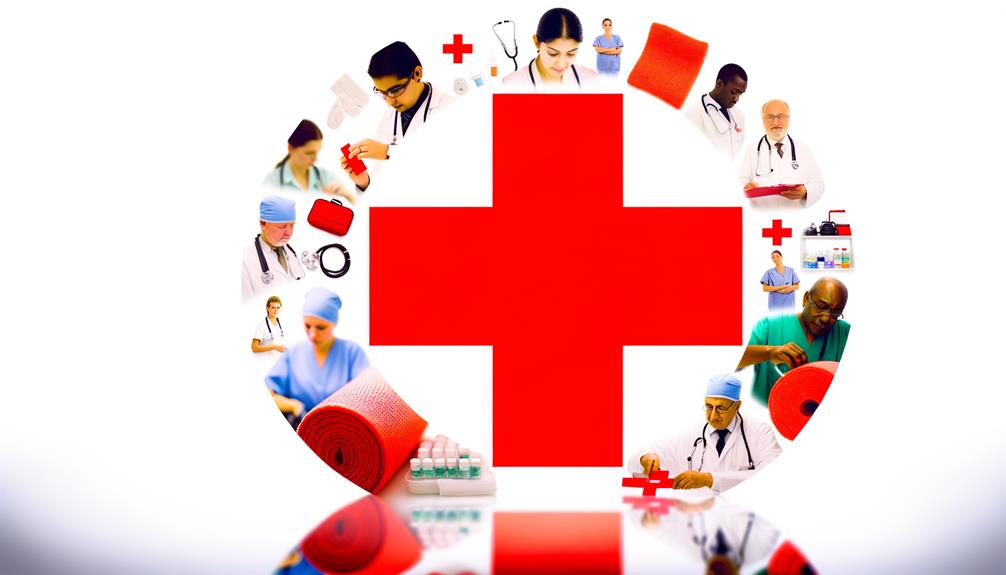
Key Takeaways
- The Red Cross symbol signifies humanitarian aid and protection.
- It represents neutrality, care, and protection in humanitarian efforts.
- The symbol ensures safe passage for medical and religious personnel in conflicts.
- It embodies the commitment to global relief efforts in crisis zones.
- The Red Cross is a universally acknowledged icon of neutrality and aid.
Origin and History

The Red Cross symbol, rooted in a legacy of humanitarianism, originated during the 19th century as a protective emblem in times of armed conflict. Conceived by Henry Dunant, a Swiss businessman and social activist, the emblem aims to shield medical personnel and facilities from the ravages of war.
This simple, easily recognizable symbol—a red cross on a white background—serves as a universal indicator of neutrality and impartial aid. It was first adopted in 1864, following the Battle of Solferino, where Dunant witnessed tremendous suffering and a dire need for organized medical assistance.
The emblem's design was inspired by the Swiss flag, reversing its colors, symbolizing neutrality and the humanitarian mission at its core.
Geneva Conventions
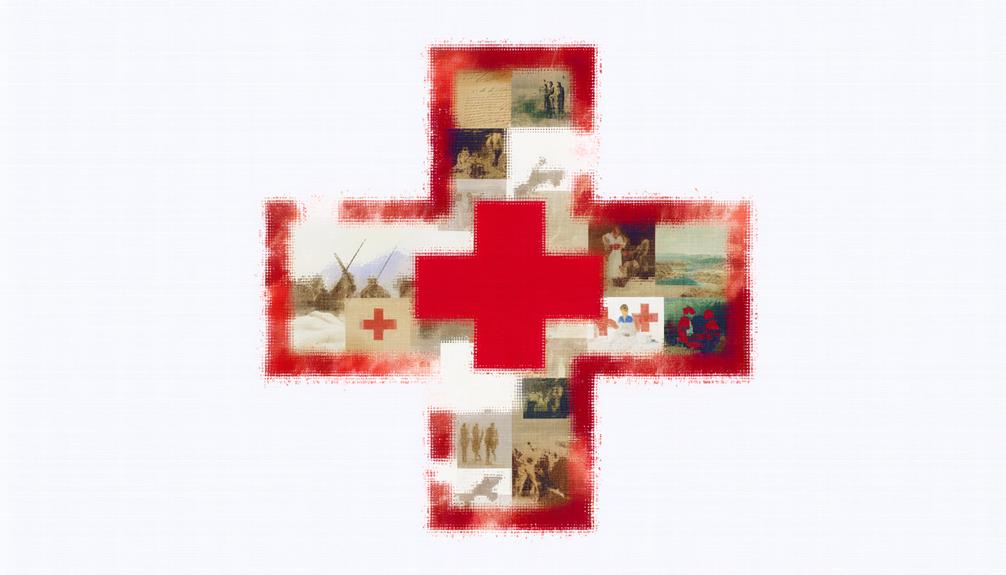
Enacted to establish legal protections in times of war, the Geneva Conventions formalized the use of the Red Cross symbol as a safeguard for medical personnel and humanitarian efforts.
These international treaties, developed between 1864 and 1949, delineate the rights and protections afforded to those who are not participating in hostilities, including the wounded, shipwrecked, prisoners of war, and civilians.
The Red Cross emblem, adopted universally, serves as a neutral indicator ensuring the safety and impartiality of medical services amid conflict.
Symbolism and Meaning

The Red Cross symbol has come to embody much more than its initial design, signifying essential elements such as humanitarian aid, neutrality, and protection.
This emblem is globally recognized, fostering a sense of trust and safety among populations affected by conflict and disaster.
Understanding these aspects underscores the profound impact and universal acceptance of the Red Cross in its mission to alleviate human suffering.
Humanitarian Aid Representation
Representing a beacon of hope and relief, the Red Cross symbol universally signifies humanitarian aid and protection during crises. This emblem is recognized globally as a symbol of neutrality, assistance, and compassion, providing assurance to those affected by conflict and disasters. The Red Cross operates under the principles of impartiality and humanity, aiming to alleviate suffering without discrimination.
| Aspect | Description |
|---|---|
| Symbolic Meaning | Represents neutrality, care, and protection in humanitarian efforts |
| Historical Context | Established by the Geneva Conventions to safeguard medical services |
| Global Recognition | Universally acknowledged and respected, ensuring safety and trust in crises |
Understanding the Red Cross's role is pivotal in appreciating its impact on global humanitarian initiatives, offering solace and aid to countless individuals in dire circumstances.
Neutrality and Protection
In times of conflict and disaster, the Red Cross symbol stands as a powerful proof to neutrality and protection, ensuring that aid reaches those in need without bias or prejudice. This emblem, recognized under international humanitarian law, signifies impartiality and a commitment to humanitarian principles. It acts as a shield for medical personnel, volunteers, and the wounded, providing a guarantee of safety amidst turmoil.
Global Recognition and Impact
Universally acknowledged, the Red Cross symbol serves as a beacon of hope and humanitarian aid, transcending borders and cultures to offer assistance where it is most required. Its global recognition guarantees immediate identification and trust, enabling swift mobilization of resources and support. The symbol's impact is profound, embodying principles of neutrality and impartiality, which are essential in conflict zones and disaster-stricken areas.
Key aspects of its global impact include:
- Emergency medical services: Immediate care in crises.
- Disaster relief: Quick response to natural and man-made disasters.
- Humanitarian advocacy: Promotion of human rights and dignity.
- Health programs: Vaccination drives and disease prevention.
- Community resilience: Training and preparedness initiatives.
This universal emblem continues to save lives and foster global solidarity.
Legal Protections
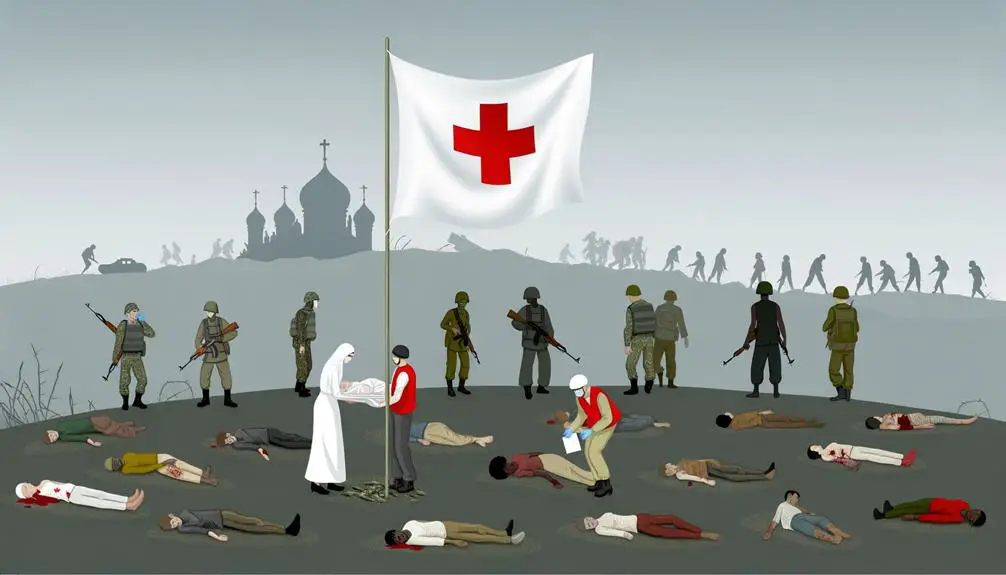
The red cross symbol is safeguarded under international law to guarantee its neutral and humanitarian mission is respected and protected globally. This protection is primarily codified in the Geneva Conventions, which stipulate that the symbol is to be used exclusively by medical and religious personnel during armed conflicts.
Unauthorized use of the red cross emblem is prohibited as it could lead to misuse, thereby endangering lives and undermining the trust and neutrality associated with the symbol. Violations can result in legal penalties, ensuring the emblem retains its integrity and purpose.
National laws complement these international agreements, reinforcing the symbol's protection and ensuring it remains a beacon of hope and aid in times of crisis.
Humanitarian Mission
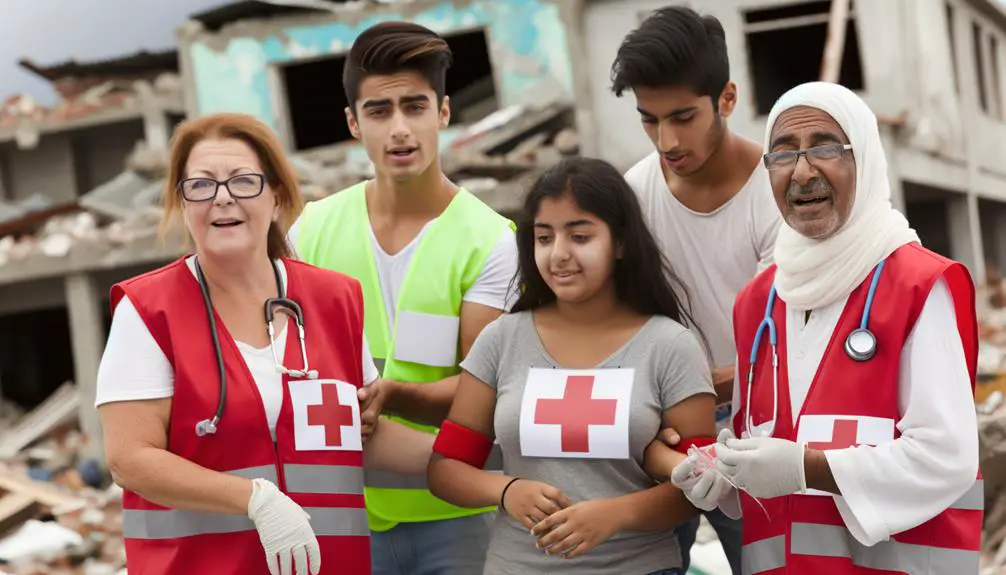
The Red Cross symbol epitomizes a commitment to humanitarian missions, emphasizing global relief efforts and emergency medical aid.
Its presence in crisis zones worldwide underscores a universal promise to alleviate human suffering and save lives.
Global Relief Efforts
Across continents, the Red Cross symbol stands as a beacon of hope and relief during times of crisis and disaster. This emblem signifies a global commitment to alleviate human suffering through coordinated humanitarian efforts.
The International Red Cross and Red Crescent Movement mobilizes resources and volunteers to support communities in distress, irrespective of geographical boundaries. Critical areas of their global relief efforts include:
- Disaster Response: Rapid mobilization during natural and man-made catastrophes.
- Health Services: Providing essential medical care and health education.
- Shelter: Offering temporary housing and rebuilding assistance.
- Food and Water: Ensuring access to safe, nutritious food and clean water.
- Community Resilience: Strengthening local capacities to withstand future crises.
These efforts underscore the Red Cross' unwavering dedication to humanity's well-being.
Emergency Medical Aid
In times of crisis, emergency medical aid provided by the Red Cross is crucial in saving lives and alleviating suffering. This humanitarian mission mobilizes rapid-response teams equipped with essential medical supplies, expertise, and compassion.
Whether addressing natural disasters, armed conflicts, or health epidemics, the Red Cross plays a key role in immediate care by setting up field hospitals, providing first aid, and facilitating medical evacuations. Their work extends to supporting local healthcare systems, offering mental health services, and coordinating with other relief organizations to maximize impact.
Global Recognition
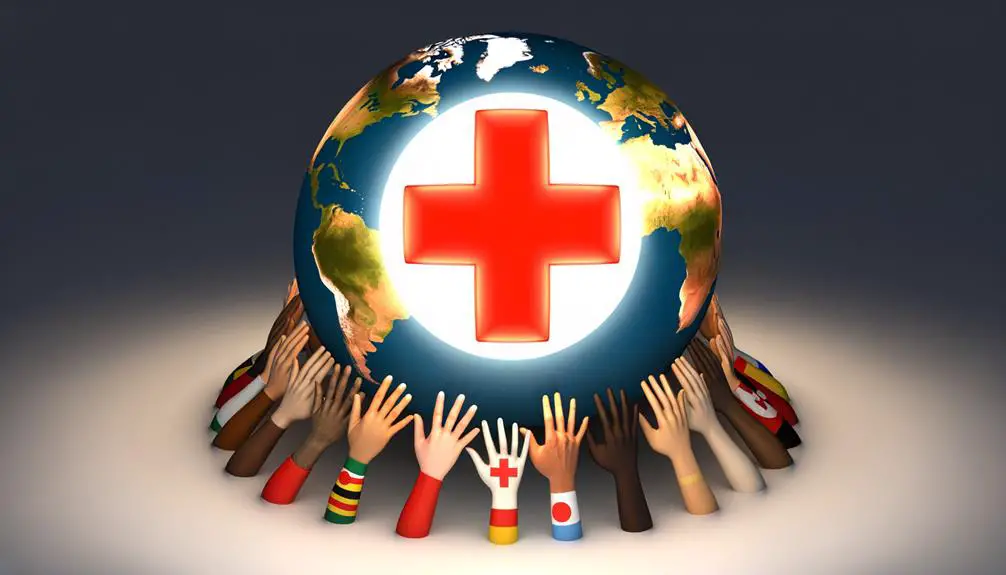
Recognized universally, the Red Cross symbol serves as a beacon of hope and neutrality in times of conflict and disaster. Its global acknowledgment guarantees that aid can be delivered swiftly and efficiently, transcending borders and cultural barriers. This symbol signifies a commitment to humanitarian principles, providing critical assistance to those in dire need.
Key aspects of its global acknowledgment include:
- International Law Compliance: Adherence to the Geneva Conventions.
- Neutrality: Ensuring impartial aid in conflicts.
- Trust: Instilling confidence in affected populations and warring parties.
- Visibility: Easily identifiable in chaotic environments.
- Unity: Representing a worldwide network of humanitarian aid.
This icon's universal acceptance underscores its role in safeguarding human dignity and alleviating suffering.
Misuse and Misconceptions
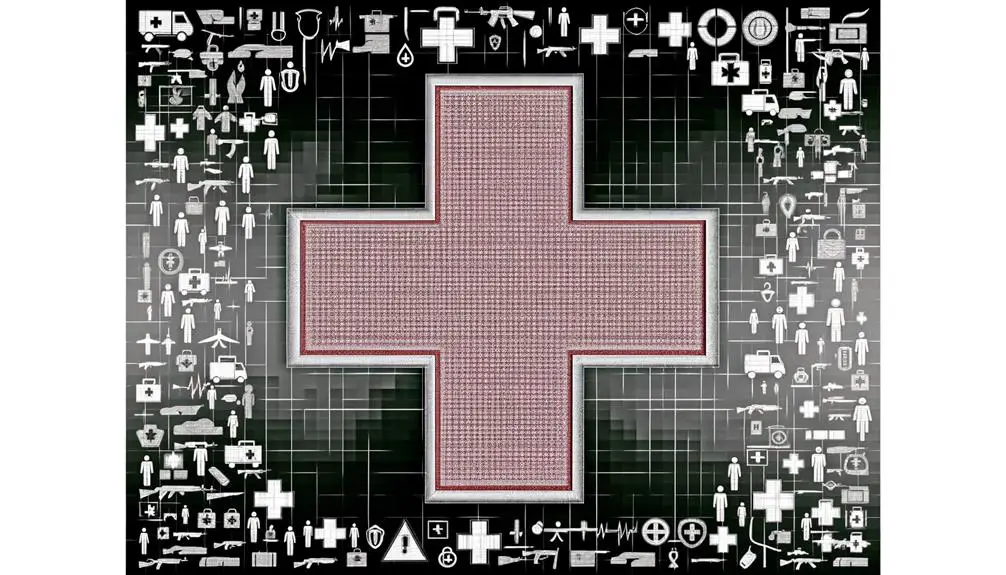
One prevalent issue surrounding the Red Cross symbol is its frequent misuse and the misconceptions it engenders. Many people mistakenly use the emblem for purposes unrelated to its humanitarian mission, such as commercial branding or medical services unaffiliated with the Red Cross. This misuse dilutes the symbol's recognized meaning and can lead to public confusion about its true purpose.
Moreover, some individuals erroneously believe that the symbol is generic for first aid or medical care, overlooking its protected status under international humanitarian law. These misconceptions not only undermine the emblem's integrity but also potentially jeopardize the safety of those entitled to its protection in conflict zones.
Clear guidelines and education are essential to preserving the symbol's sanctity and significance.
Red Cross Vs. Red Crescent

The Red Cross and Red Crescent symbols are distinct emblems used by the International Red Cross and Red Crescent Movement to provide humanitarian aid across different cultural and religious contexts. These symbols guarantee neutrality and protection for medical personnel and those affected by conflict.
The choice between the Red Cross and Red Crescent is often influenced by cultural and religious considerations in different countries.
- Red Cross: Originated in 1863, inspired by the Swiss flag.
- Red Crescent: Adopted in 1876, more acceptable in Muslim-majority countries.
- Neutrality: Both symbols signify impartiality and non-religious affiliation.
- Usage: Countries choose the emblem that best fits their cultural context.
- Universal Recognition: Both symbols are recognized under international humanitarian law.
These emblems play an essential role in ensuring humanitarian aid is delivered effectively and without prejudice.
Impact on Society

Understanding the impact of the Red Cross and Red Crescent symbols on society involves recognizing how these emblems facilitate trust and cooperation in humanitarian efforts worldwide. These symbols are universally acknowledged as icons of neutrality and protection, ensuring safe passage for aid workers and resources in conflict zones and disaster-stricken areas. Their presence reassures affected communities of impartial assistance and fosters collaboration among international organizations, governments, and local entities.
| Aspect | Red Cross Symbol | Red Crescent Symbol |
|---|---|---|
| Recognition | Widely known globally | Mainly in Muslim regions |
| Role in Conflict | Symbol of neutrality | Symbol of neutrality |
| Humanitarian Impact | Facilitates aid distribution | Facilitates aid distribution |
The shared commitment to humanity and neutrality embodied by these symbols greatly enhances their societal impact.
Conclusion
The red cross symbol, steeped in historical significance and born from the crucible of conflict, stands as a beacon of humanitarian ideals and legal sanctity. Its universal recognition underscores a collective commitment to alleviating human suffering.
Despite occasional misinterpretations and misuse, the symbol's essence remains unblemished, bridging cultural divides through its twin, the red crescent. This emblematic figure continues to inspire compassion and solidarity, fostering a more humane society in times of both peace and turmoil.





